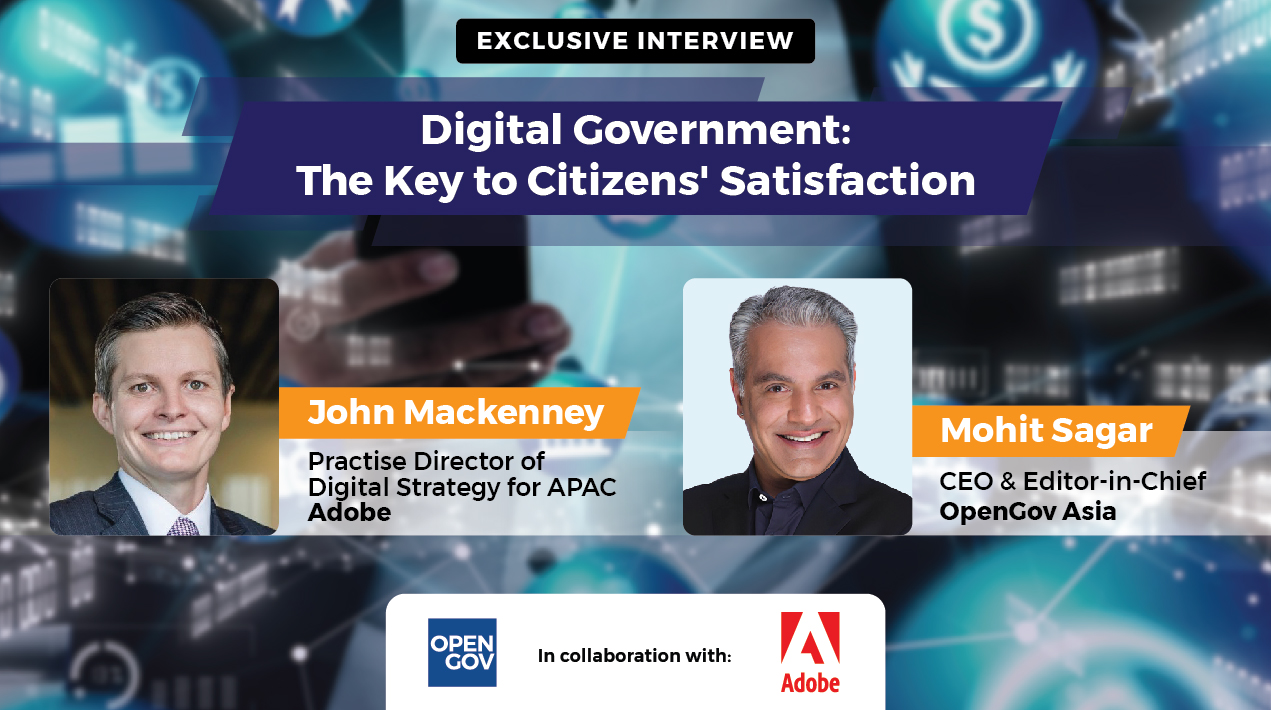
|
Getting your Trinity Audio player ready...
|
In an exclusive interview with OpenGov Asia, John Mackenney, Practise Director of Digital Strategy for APAC, Adobe shares insights from his deep experience into the changing landscape of public sector services and citizens’ satisfaction.
An expert in government initiatives and digital transformation, John delved into the shifts observed since the COVID-19 pandemic and explored the evolving government frameworks in Southeast Asia. He highlighted the recalibration of priorities and the emphasis on efficiency in the public sector, underscoring the need for a deeper understanding of the economic impact of digitalisation.
 Reflecting on the impact of COVID-19 on government initiatives, John believes that the pandemic served as a major catalyst for change, driving rapid digital transformation across various sectors. He acknowledged the significance of the pandemic in shaping government agendas but also noted a notable shift in focus. There was a change in priorities, with a growing emphasis on achieving efficiency within the public sector.
Reflecting on the impact of COVID-19 on government initiatives, John believes that the pandemic served as a major catalyst for change, driving rapid digital transformation across various sectors. He acknowledged the significance of the pandemic in shaping government agendas but also noted a notable shift in focus. There was a change in priorities, with a growing emphasis on achieving efficiency within the public sector.
John draws attention to the initial surge of government investments and rapid deployments witnessed during the peak of the pandemic. However, as the immediate crisis began to subside, governments globally began to reassess their strategies and budgets. This shift led to a recalibration of projects and a re-evaluation of the value proposition of digital initiatives in the public sector.
In reviewing the journey thus far, there is a clear inward focus that has emerged in the post-COVID era. Governments are now actively seeking ways to optimise operations within the public sector. While the return to physical offices may not be universal, flexible working arrangements have gained prominence. This flexibility aligns with the broader objective of improving efficiency within government bodies.
The observable trend of transformation programmes in the public sector is the slowing down from their initial pace. This deceleration can be attributed to various factors, including budget constraints and the need for a more comprehensive understanding of the value that digitalisation can bring.
One of the critical points is the evolving value proposition of digital government frameworks. While the initial messaging focused on time savings for citizens and efficient processes, there is a growing need to delve deeper into the economic impact of these initiatives.
“The absence of a comprehensive understanding of the economic drivers and benefits of digitisation can hinder investment and hinder potential progress,” John says.
To illustrate this, he uses the example of inclusion and reaching marginalised populations. While governments acknowledge the importance of inclusion, they may not fully comprehend the significance of quantifying the economic cost of exclusion. By calculating the economic implications of not including certain segments of society, governments can better comprehend the potential gains from digitalisation efforts.
“The move towards digitalisation in government services is not just about convenience; it’s about recognising and mitigating the hidden economic costs of inefficiency,” John reiterates.
He contrasted the situations in Australia and New Zealand, where lifestyle changes had motivated shifts in government approaches, with those in Southeast Asia where a return to pre-pandemic norms has prompted renewed waiting lines and bottlenecks.
He stresses the importance of data in driving change and underscores the necessity of accurate numbers to justify the allocation of resources towards digital initiatives, “In addition to the essential elements of government digitalisation, there’s a crucial aspect that cannot be overlooked – measurability.”
Without a comprehensive understanding of the benefits of digitalisation, governments risk reverting to older, less efficient models of operation. By measuring and quantifying the economic gains and losses associated with digital initiatives, governments can make informed decisions and continue progressing toward efficient and inclusive public services.
When considering the significant economic consequences of ineffective public services for citizens and the overall economy, it becomes evident that the seemingly minor tasks of waiting on hold and queuing up for government services have concealed costs that go beyond mere inconvenience.
Experts often underestimate the impact of traditional service channels like call centres and in-person visits on citizens’ time and productivity. John reinforces this viewpoint by presenting a scenario where a seemingly quick task could spiral into hours wasted. Waiting on hold, followed by explaining the issue to a community service agent and potentially dealing with more tasks afterwards, compounds the inefficiency.
In such instances, it’s crucial to assess the real economic toll of ineffective service delivery. While the immediate time spent waiting and completing tasks is significant, John highlights that the broader consequences are even more significant.
For example, someone who must physically visit a government office not only invests time in the task itself but also bears indirect expenses tied to commuting, waiting in lines, and potentially taking time off from work.
The economic impact extends beyond individual encounters, particularly in areas with traffic congestion or remote locations. In such cases, the effects are magnified, with some individuals experiencing a two or threefold increase in time-related costs. Consequently, this leads to delayed access to crucial services, impeding economic efficiency, and restraining individuals from fully contributing to society.
John notes a distressing reality: the most impacted by these inefficiencies are the vulnerable members of society – the very individuals government initiatives are meant to assist. This irony showcases the urgency of addressing this issue. The repercussions include diminished motivation, delayed access to healthcare, and reduced economic productivity for those who need support the most.
Shifting the focus to the government’s role, it becomes crucial to grasp the significant obstacles people encounter when transitioning to digital service delivery. John emphasises that the lack of comprehension and quantification of the economic toll acts as a barrier to meaningful progress. Without gauging the full scope of impacts, governments inadvertently invest resources in tackling the wrong challenges or inefficiently distributing funds.
Governments must comprehend the entirety of the cost-to-serve framework. This involves measuring the economic losses stemming from inefficient services and recognising that these losses are often disproportionately higher for marginalised groups. Equipped with this insight, governments can tailor their digital initiatives to effectively address the most pressing concerns, ultimately alleviating the burden on citizens and the economy.
Navigating the intricate landscape of digital government initiatives, John lays out fundamental criteria that delineate the success of such endeavours. These criteria shed light on the factors contributing to the formidable challenge of enhancing citizens’ satisfaction through streamlined digital services.
According to John, the bedrock of successful digital government initiatives is a citizen-centric approach. This entails crafting services around the specific tasks citizens aim to complete, rather than aligning with the government’s internal procedures. This approach prioritises user needs, enhancing the overall service experience.
Notably, he underscores the significance of mobile responsiveness. In today’s digital era, where mobile access is pervasive, services must seamlessly operate on mobile devices. This adaptability ensures accessibility to a broader audience.
Moreover, the swiftness and efficiency of platforms are paramount. Regardless of geographical location or network capabilities, services should deliver optimal speed and performance, enabling users to engage without hindrance.
Recognising the multicultural fabric of societies, John underscores the pivotal role of accessibility and readability. This is particularly crucial in diverse environments, where information must be understandable to varied audiences. These attributes collectively contribute to the triumphant execution of digital government initiatives.
John offers insights into impactful digital government initiatives that have set new standards for enhancing citizen satisfaction:
- Enhanced My Gov Programme (Australia): This initiative transformed from a distributed ecosystem into a consolidated platform offering essential life event information. Citizens can access transactions, navigate government services, and manage tasks seamlessly from their mobile devices. The transition was driven by aggregation, citizen-centric design, and a mobile-first approach.
- Services NSW (New South Wales, Australia): The success of Services NSW stems from the integration of digital and offline experiences. The initiative not only provides digital tools but also promotes digital literacy among citizens. Personalisation plays a significant role, ensuring tailored services and information for different user groups, ultimately enhancing the user experience.
- Government of Canada: With 42 government departments consolidated into one platform, Canada’s initiative simplifies citizens’ access to a wide range of government information and services. This centralised approach aids citizens in navigating major life events, while the platform’s capabilities contribute to improved user experiences.
John believes, “Effective measurement encompasses several key factors. Firstly, it involves assessing the Net Promoter Score (NPS) and regularly soliciting feedback from users to gauge the effectiveness of digital content and services.”
However, going beyond feedback, governments should conduct comprehensive testing. This includes evaluating the website’s loading speed and ensuring optimal performance even in diverse network conditions. Also, it entails testing the findability of content through search engines, enhancing user accessibility.
John acknowledges the challenges governments face in transitioning to efficient digital services. He highlighted the persistence of siloed operations within government departments and the need for comprehensive alignment around citizen needs. Additionally, he pointed out the importance of retraining the public sector to equip them with the digital skills needed to effectively serve citizens in the digital age.
John also spoke about the complex realm of data security, privacy, and establishing trust in the context of digital government services, sharing the pivotal role that data security and privacy play in building trust and ensuring citizen satisfaction within government services.
“Trust is the cornerstone and hinges on governments delivering on their commitments. It’s about doing what you say you’re going to do,” John believes. “To cultivate trust, governments must adhere to their promises, thus reinforcing their credibility.”
Transparency, he emphasised, plays a crucial role in building trust. By providing citizens with a clear understanding of the data collected and how it’s used, governments can instil confidence in their digital initiatives.
Transparency, in turn, is intrinsically linked to control. Citizens should have a level of control over the data they share and how it’s utilised. This extends to advanced uses of artificial intelligence (AI), where governments may leverage data to provide personalised recommendations. By granting citizens the ability to influence their data usage, governments can build a framework that respects individual preferences and fosters trust.
Navigating trust, data security, and privacy becomes more intricate in areas like healthcare and unemployment management. John highlighted the necessity of safeguarding sensitive information related to health and employment status. Governments must ensure that citizens’ health data is secure and that unemployment information is handled with the utmost discretion.
John is convinced of the role of digital identity in building trust. A comprehensive digital identity framework not only provides secure access but also enables citizens to manage their preferences. The ability to personalise data usage adds an extra layer of trust by giving citizens a stake in their digital experiences.
Implementing digital transformation within government often encounters significant resistance to change, driven by various factors including concerns over data security and privacy, unfamiliarity with new processes, and a general reluctance to embrace change. John explored the challenges posed by resistance to change and the strategies that can effectively address them.
Resistance to change is a formidable challenge, stemming from inherent human aversion to change. He lays bare the multifaceted nature of the issue, including data privacy and security concerns that may hinder the implementation of personalised experiences. The balancing act between delivering personalised services and maintaining data security becomes a delicate process, often accompanied by fears of data breaches and compromised privacy.
John further highlighted the importance of considering dynamic consent and transparency. Citizens’ preferences and willingness to share data may fluctuate over time, necessitating an adaptable approach to data usage. Governments must ensure that citizens have the tools to modify their data-sharing preferences and remain informed about the evolving landscape of data privacy and usage.
Addressing resistance to change requires a comprehensive digital identity framework that facilitates secure access, personalised experiences, and granular control over data sharing. John underscored the significance of a connected ecosystem, where data from various government departments can be seamlessly integrated to support citizen journeys. Such an ecosystem not only aids in providing better services but also ensures compliance with evolving privacy and governance regulations.
When it comes to spearheading digital transformation to enhance citizen satisfaction, John offered actionable advice rooted in practicality. He recommended that government leaders focus on specific pain points and journeys that citizens encounter. Rather than attempting to overhaul the entire system in one go, tackling challenges one at a time is a more manageable and effective approach.
Technology, such as Adobe’s solutions, plays a pivotal role in simplifying the transformation process. By addressing the technology challenges for one journey or life event, governments can subsequently apply the same solutions to multiple scenarios. The efficiency gained from this approach eliminates the need to recreate systems repeatedly and enables a scalable transformation process across multiple use cases.
The emergence of Generative AI and the rise of conversational AI models like ChatGPT have the potential to reshape how citizens interact with government content and services. While there are significant benefits to leveraging these technologies, there are also challenges that need to be addressed, particularly in the context of a distributed content ecosystem and language diversity. John shed light on these challenges and their implications in a conversation with OpenGov Asia.
Generative AI has the power to enhance citizen engagement and inclusion by providing personalised experiences and enabling natural language interactions. For example, citizens can ask questions using their own words and receive relevant information in return. This is particularly advantageous for reaching diverse groups of citizens, including those with lower literacy levels and varying language preferences.
However, the challenges arise from the decentralised nature of the content ecosystem. Government content is often distributed across various departments and agencies, resulting in fragmented and conflicting information. This poses a risk that users may receive incorrect or outdated information when interacting with AI models.
In the context of Southeast Asia, where multiple languages and dialects are prevalent, the challenges of language diversity are amplified. While English content might be well-optimised for search engines and AI models, content in local languages might not receive the same level of visibility due to lower SEO rankings. Additionally, content in local languages might not have been created with the same digital user experience in mind, leading to potential mismatches between user queries and available content.
Addressing these challenges requires collaboration among government agencies to create unified and authoritative content. Governments need to ensure that content is accurate, up-to-date, and accessible across multiple languages. This involves not only adapting existing content to be conversational but also creating content specifically designed for AI interactions.
Adobe’s role in this landscape is significant. With its technology solutions, Adobe can help governments manage and optimise their content for AI interactions. By creating content that is not only language-appropriate but also aligned with the needs of AI models, governments can enhance the accuracy and relevance of AI-generated responses.
Adobe’s capabilities in managing digital experiences, personalisation, and content optimisation can be leveraged to improve citizen engagement through AI-powered interactions.
Interestingly personalisation is a term that often stirs debate in government circles. However, when stripped down to its essence, it revolves around simplicity and efficiency.
Unlike other platforms, like media and entertainment, where the goal is to keep users engaged for longer periods, a successful government experience is one where citizens can swiftly access what they need and then move on with their lives.
“In essence, personalisation in government is about giving citizens back valuable time in their day, allowing them to focus on their families, jobs, and contributing to the economy,” John points out.
Looking ahead to the next two to three years, John shared his insights on the trends and innovations that are likely to have a substantial impact on citizens’ satisfaction and government service delivery:
- Integration of AI into Everyday Tools: The integration of AI and Generative AI capabilities into everyday tools and technologies will change the way people interact with information. This will go beyond specialised AI platforms and become a part of common tools like search engines and productivity suites. This shift will drive governments to rethink their communication strategies and adapt to new interfaces for delivering information and services.
- Transformation of Government Communication: The transformation in how people access and consume information will lead to a reevaluation of government communication strategies. As the way citizens interact with content evolves, governments will need to reconsider the sprawling landscape of government websites and find new ways to communicate effectively with citizens. This transformation could result in a more streamlined and targeted approach to content delivery.
- Personalised Government Services: The continued push towards personalised government service delivery will remain a prominent trend. AI technologies will enable governments to tailor information and services to individual citizens’ needs, improving user experiences and satisfaction. This trend will likely contribute to more efficient and effective government interactions.
- Increased Connectivity and Collaboration: The evolving digital landscape will drive governments to become more connected and collaborative. As citizens become accustomed to seamless interactions in their daily lives, governments will need to work across departments to offer integrated and holistic services. This may involve breaking down silos and creating a unified approach to serving citizens.
- Shift Toward Accessibility and Inclusion: The increased use of AI and conversational AI models presents an opportunity for governments to enhance accessibility and inclusion. By offering information and services in multiple languages and accommodating diverse user needs, governments can ensure that their services are available to all citizens.
- Ethical Considerations and Bias Mitigation: As AI becomes more integrated into government processes, addressing ethical considerations and mitigating bias will become crucial. Governments and technology providers will need to work together to ensure that AI-generated information is accurate, unbiased, and culturally sensitive, particularly in diverse regions like Asia.
In the short term, the world is likely to witness significant shifts in how citizens interact with government information and services. The integration of AI, particularly Generative AI, into everyday tools will redefine the user experience and prompt governments to reevaluate their communication strategies.
Personalised services, increased connectivity, and a focus on accessibility and inclusion will all contribute to a more efficient and citizen-centric government service delivery. However, as these technologies advance, ethical considerations and bias mitigation will play a pivotal role in ensuring the accuracy, fairness, and cultural sensitivity of AI-generated content and responses.
In the fast-evolving landscape of digital transformation and the emergence of artificial intelligence (AI), governments around the world are faced with a critical juncture. The integration of advanced technologies, particularly AI-driven solutions like Generative AI (Gen AI), presents opportunities to enhance citizen services and satisfaction, but also raises complex challenges that demand careful consideration.
As governments seek to leverage AI and Gen AI to meet the evolving needs of citizens, a pivotal moment is emerging. The potential benefits are significant: improved service delivery, personalised interactions, and streamlined processes that boost citizens’ satisfaction. However, a challenging paradox has emerged. The very tools designed to enhance citizen experiences are met with resistance and apprehension in some government circles.
One of the most pressing challenges governments face is the varying speeds of adoption. While Generative AI offers a promising avenue for better service delivery, some government entities have hesitated to fully embrace the technology. In certain cases, there are instances of outright bans or restrictions on its use. Paradoxically, within these same government bodies, public servants are engaging with Gen AI tools in their personal lives, underscoring the disconnect between policy and practice.
The diverse cultural and linguistic landscape in different regions poses another layer of complexity. Language nuances and cultural sensitivities must be taken into account when designing AI systems. Failure to do so can lead to inaccurate or inappropriate information dissemination. In a world where AI-generated responses become the norm, these cultural nuances become all the more critical, particularly in Asian regions with vast cultural diversity.
In the quest for digital innovation, governments must walk a fine line between embracing new technologies and ensuring that inclusivity is not compromised. Rushing to adopt complex platforms without considering the digital literacy of citizens can lead to the exclusion of certain age groups, notably those less tech-savvy or familiar with navigating digital interfaces.
While the term “digital literacy” is often used to emphasise upskilling citizens, it is essential to avoid creating overly complex systems and necessitate assistance from younger generations. Striving for inclusivity means ensuring that advancements benefit all citizens, regardless of age or digital proficiency.
The urgency to adapt and adopt Gen AI and other transformative technologies requires governments to reevaluate their strategies. A balance must be struck between fostering innovation and catering to the diverse needs of the population. Collaborative efforts between governments, technology providers like Adobe, and citizens are necessary to ensure that digital transformation is carried out with the citizen experience and satisfaction at its core.
In the Asian region, which boasts intricate cultural and linguistic diversity, a distinct challenge emerges in the era of Gen AI. Here, leapfrogging, not playing catch-up should be the strategy, John says. Rather than emulating strategies employed by technologically advanced nations, an opportunity exists to skip certain stages and tailor strategies to align with regional contexts.
This is particularly pertinent for nations with nascent digital infrastructure, enabling them to embrace advanced Gen AI capabilities more expeditiously.
As governments prioritise efficiency and optimisation in the public sector, understanding the economic impact of digitalisation is crucial. Accurate measurement of benefits ensures meaningful results from investments, driving positive change in citizens’ satisfaction and societal progress. Inefficient public services carry hidden costs that range from lost productivity to delayed access to vital services, underscoring the need for quantitative assessment.
Beyond a doubt, government initiatives play a vital role in enhancing citizen experiences through efficient digital services. However, addressing these challenges will enable governments to assist vulnerable populations while fostering productivity and efficiency.
A roadmap for success would encompass citizen-centricity, mobile responsiveness, accessibility, and the integration of digital and offline experiences. By studying these successful initiatives and addressing challenges head-on, governments can create a digital landscape that truly serves and satisfies their citizens.
Overcoming resistance to change is a critical step in realising successful digital transformation within government services. By acknowledging concerns, embracing dynamic consent, and leveraging technology to simplify the process, government leaders can navigate the path toward enhanced citizen satisfaction, personalised experiences, and an ecosystem that prioritises data security and privacy.
Related articles:
















